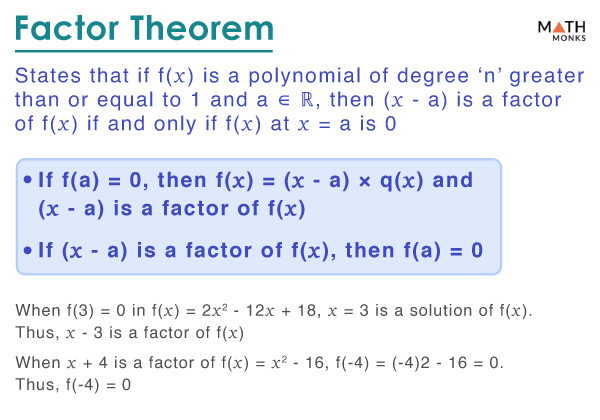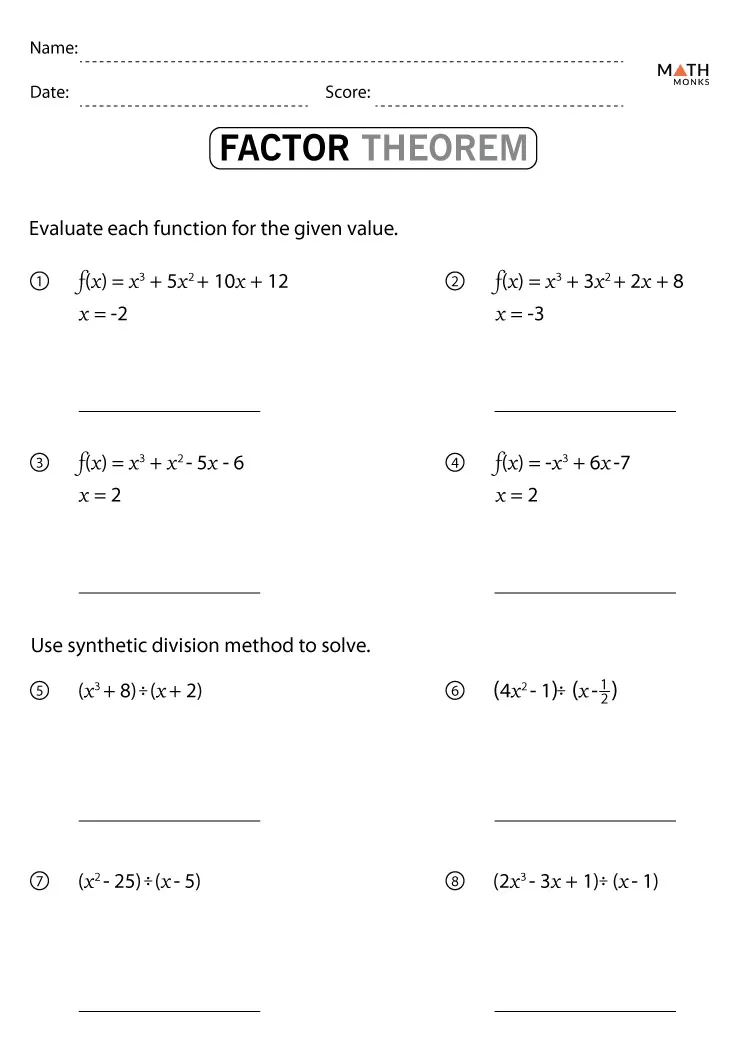The factor theorem states that if f(x) is a polynomial of degree n (≥ 1) and ‘a’ is a real number, then (x – a) is a factor of f(x), if and only if f(a) = 0
Thus, if we substitute a number for x in a polynomial and get zero, then x minus that number is a factor of the polynomial.
Formula
Mathematically,
If f(a) = 0, then f(x) = (x – a) × q(x)
Thus, (x – a) is a factor of f(x)
Also, if (x – a) is a factor of f(x)
Such that f(x) = (x – a) × q(x), then f(a) = 0
This is, thus, an extension of the remainder theorem and is commonly used to factor a polynomial and find its roots.
Proof
Let us consider a polynomial f(x), which is being divided by another polynomial (x – a)
If the quotient is q(x), and the remainder is f(a).
From the remainder theorem, we know
f(x) = (x – a) × q(x) + f(a)
By substituting f(a) = 0, we get
f(x) = (x – a) × q(x) + 0
⇒ f(x) = (x – a) × q(x)
Since (x – a) completely divides f(x), (x – a) is a factor of f(x)
Thus, if f(a) = 0, then (x – a) is a factor of f(x)
Now, let (x – a) be a factor of f(x)
Thus, f(x) = (x – a) × q(x)
⇒ f(x) = (x – a) × q(x) + 0
On comparing with the remainder theorem, we get
The remainder = f(a) = 0
Thus, if (x – a) is a factor of f(x), then f(a) = 0
How to Use Factor Theorem
Let us find the factors of the polynomial f(x) = x2 + 4x – 5
Assuming f(x) = 0 and solving further, we get
x2 + 4x – 5 = 0
⇒ x2 + 5x – x – 5 = 0
⇒ x(x + 5) – 1(x + 5) = 0
⇒ (x + 5)(x – 1) = 0
Thus, we get either (x + 5) = 0 or (x – 1) = 0
⇒ x = -5 or x = 1
If f(x) = 0, the values of x are called the roots of the function.
Here, the roots or the zeros of f(x) = x2 + 4x – 5 are 1, -5
The factors of f(x) = x2 + 4x – 5 are (x – 1), (x + 5)
Now, using the factor theorem, we get
If x = -5 is a root of f(x), then
f(-5) = (-5)2 + 4(-5) – 5 = 25 – 20 – 5 = 0
If x = 1 is a root of f(x), then
f(1) = (1)2 + 4(1) – 5 = 1 + 4 – 5 = 0
Since the remainders f(-5) and f(1) are zero, (x + 5) and (x – 1) are the factors of f(x), which proves that -5 and 1 are the zeros of the polynomial f(x).
Also, if x = a is a root of the polynomial, then (x – a) is a factor of it, and vice versa.
Solved Examples
![]() Verify whether p + 1 is a factor of p4 + 2p2 + 1
Verify whether p + 1 is a factor of p4 + 2p2 + 1
Solution:
![]()
Here, f(p) = p4 + 2p2 + 1
By putting (p + 1) = 0
⇒ p = -1
At p = -1, we get f(p) = f(-1)
⇒ f(-1) = (-1)4 + 2(-1)2 + 1
⇒ f(-1) = 1 + 2 + 1
⇒ f(-1) = 4
Thus, p + 1 is not a factor of p4 + 2p2 + 1
![]() Verify whether x = ${\dfrac{2}{5}}$ is a root of f(x) = 125x3 – 20x + 4
Verify whether x = ${\dfrac{2}{5}}$ is a root of f(x) = 125x3 – 20x + 4
Solution:
![]()
For x = ${\dfrac{2}{5}}$,
We get,
${f\left( x\right) =f\left( \dfrac{2}{5}\right)}$
= ${125\left( \dfrac{2}{5}\right) ^{3}-20\left( \dfrac{2}{5}\right) +4}$
= (2)3 – 4(2) + 4
= 4
Thus, x = ${\dfrac{2}{5}}$ is not a root of f(x) = 125x3 – 20x + 4
![]() Use the factor theorem to verify if 2y + 3 is a factor of the polynomial 4y2 + 12y + 9
Use the factor theorem to verify if 2y + 3 is a factor of the polynomial 4y2 + 12y + 9
Solution:
![]()
Here, f(y) = 4y2 + 12y + 9
By evaluating for y, we get
(2y + 3) = 0
⇒ 2y = -3
⇒ y = ${\dfrac{-3}{2}}$
Using the factor theorem, at y = ${\dfrac{-3}{2}}$, we get
${f\left( y\right) =f\left( \dfrac{-3}{2}\right)}$
= ${4\left( \dfrac{-3}{2}\right) ^{2}+12\left( \dfrac{-3}{2}\right) +9}$
= (-3)2 + 12(-3) + 9
= 9 – 18 + 9
= 0
Thus, 2y + 3 is a factor of the polynomial 4y2 + 12y + 9
![]() Use the factor theorem to verify if 3n + 4 is a factor of the polynomial 6n2 + 11n + 4
Use the factor theorem to verify if 3n + 4 is a factor of the polynomial 6n2 + 11n + 4
Solution:
![]()
Here, f(n) = 6n2 + 11n + 4
By evaluating for n, we get
(3n + 4) = 0
⇒ 3n = -4
⇒ n = ${\dfrac{-4}{3}}$
Using the factor theorem, at n = ${\dfrac{-4}{3}}$, we get
${f\left( n\right) =f\left( \dfrac{-4}{3}\right)}$
= ${6\left( \dfrac{-4}{3}\right) ^{2}+11\left( \dfrac{-4}{3}\right) +4}$
= ${6\times \dfrac{16}{9}-\dfrac{44}{3}+4}$
= ${\dfrac{32}{3}-\dfrac{44}{3}+4}$
= ${\dfrac{32-44+12}{3}}$
= 0
Thus, 3n + 4 is a factor of the polynomial 6n2 + 11n + 4


